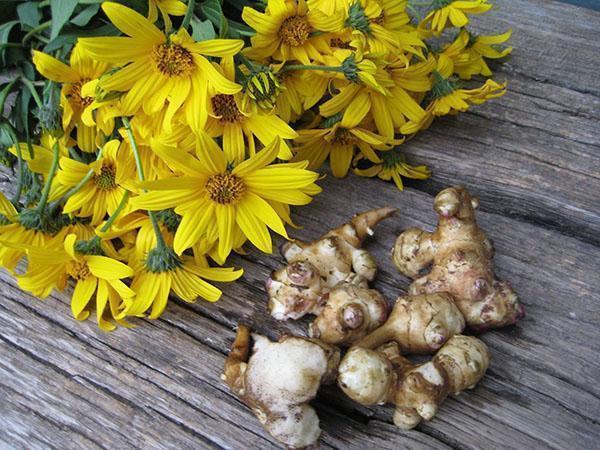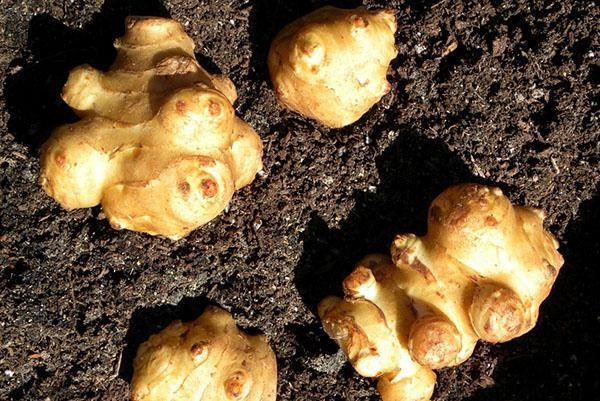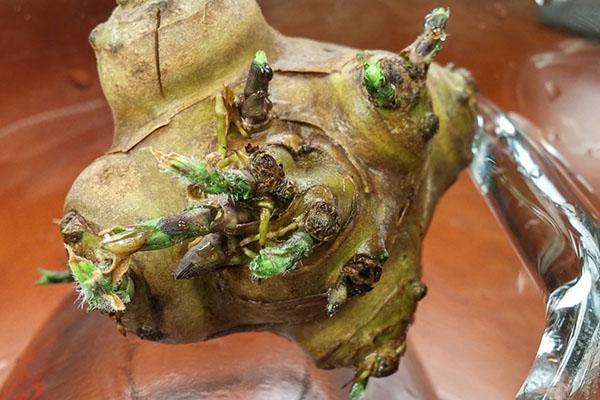Jerusalem artichoke can and should be grown in a summer cottage
 The Russians first got acquainted with Jerusalem artichoke as a garden crop relatively recently. But thanks to the record endurance of the plant, the benefits of its tubers and high yield, growing Jerusalem artichoke aroused interest in many regions, even related to the zone of risky farming.
The Russians first got acquainted with Jerusalem artichoke as a garden crop relatively recently. But thanks to the record endurance of the plant, the benefits of its tubers and high yield, growing Jerusalem artichoke aroused interest in many regions, even related to the zone of risky farming.
For the tubers formed on the roots of Jerusalem artichoke, the culture is popularly called “earthen pear". But as a result of biochemical studies, it was found that the crop from Jerusalem artichoke is much healthier than the known fruits and potatoes... Tubers are rich not only in starchy substances, sugars, fiber and vitamins. They contain substances that help maintain the well-being of hypertension and diabetes. Yes, and the endurance of the Jerusalem artichoke plants shown in the photo is such that it allows the tubers to winter in the open field without any additional shelters.
When and how to plant Jerusalem artichoke? What are the features of caring for an unusual culture?
A perennial herbaceous culture, outwardly reminiscent of tall sunflower plants with caps of medium-sized orange inflorescences at the top, propagates by tubers and seeds.
But if in the first case the harvest can be obtained by autumn, then Jerusalem artichoke seeds propagate longer. In the first year, at best, the bush will be able to form several small nodules, which will only develop into a healthy powerful plant only next spring. It is worth waiting for a real harvest from him.
Therefore, most often, to obtain not seed material, but an edible crop, tubers or their fragments are planted.
How to plant Jerusalem artichoke in the country?
Jerusalem artichoke is unpretentious and easily develops in any soil, provided there is sufficient permeability to oxygen and moisture. The lack of humus in the soil can be compensated by literate dressing... But if you plant the tubers in dense, poorly aerated black soil, even an abundance of food will not help you get a good harvest.
The tubers are embedded in the soil in the spring when the soil warms up to 16-18 ° C. However, before planting Jerusalem artichoke, it is important to prepare the beds. They have been doing this since the fall:
- digging the area allotted for culture to the depth of the bayonet;
- choosing rhizomes of perennial weeds;
- fertilizing the soil, for example manure, which over the winter will perepere and become a good top dressing for Jerusalem artichoke.
It is not necessary to break up clods and level ridges, since the main work lies in the spring. Jerusalem artichoke planting in most regions falls on the second half of April or early May.
 Before planting Jerusalem artichoke in the spring, you need to select healthy large tubers without signs of disease or pest damage. The better the planting material is, the sooner it will give strong sprouts, and in the fall the summer resident will be able to harvest a friendly harvest. If there are not so many large, even tubers, the existing ones can be cut so that on each part there is a clearly visible healthy eye. In this case, the cut sites are dried and sprinkled with crushed coal.
Before planting Jerusalem artichoke in the spring, you need to select healthy large tubers without signs of disease or pest damage. The better the planting material is, the sooner it will give strong sprouts, and in the fall the summer resident will be able to harvest a friendly harvest. If there are not so many large, even tubers, the existing ones can be cut so that on each part there is a clearly visible healthy eye. In this case, the cut sites are dried and sprinkled with crushed coal.
 Before planting, the beds are re-dug, loosened and leveled, marking rows with a width of at least 70 cm.The planting material is sealed to a depth of 15 cm.In this case, tubers should fall into the holes or trenches at a distance of 30 to 50 cm.
Before planting, the beds are re-dug, loosened and leveled, marking rows with a width of at least 70 cm.The planting material is sealed to a depth of 15 cm.In this case, tubers should fall into the holes or trenches at a distance of 30 to 50 cm.
It is extremely important to adhere to such serious gaps between individual bushes and rows. During the summer months, Jerusalem artichoke plants can reach heights of up to 2.5 meters, creating a solid wall of strong, densely leafy stems in the beds and seriously complicating the cultivation and care of Jerusalem artichoke.
In warm weather, while maintaining soil moisture, young green stems will soon rise above the beds, revealing heart-shaped pointed leaves.
How to grow Jerusalem artichoke?
 Knowing about the endurance and ability of Jerusalem artichoke to grow even on roadsides and wastelands, many summer residents make a serious mistake, letting this culture go by itself. Having planted the tubers in the ground, the second time they approach the plants only in the fall, when it is time to dig out the harvest. Imagine a surprise when only a few highly branched medium-sized tubers are found under powerful bushes.
Knowing about the endurance and ability of Jerusalem artichoke to grow even on roadsides and wastelands, many summer residents make a serious mistake, letting this culture go by itself. Having planted the tubers in the ground, the second time they approach the plants only in the fall, when it is time to dig out the harvest. Imagine a surprise when only a few highly branched medium-sized tubers are found under powerful bushes.
No matter how modest in its requests Jerusalem artichoke, but when growing, it will not work without the simplest care. How to provide care for Jerusalem artichoke when growing crops in the country?
Before emergence, it is important:
- prevent the appearance of a dense moisture and airtight crust on the soil surface, therefore, the soil is carefully loosened, focusing on the ridges of the rows left after embedding;
- weed and remove all weeds.
These activities when growing Jerusalem artichoke are carried out regularly and after the appearance of young plants.
From the moment of planting and practically until harvesting, large Jerusalem artichoke bushes need abundant watering, carried out at least once a month.
 How to grow Jerusalem artichoke in the country, giving a bountiful healthy harvest?
How to grow Jerusalem artichoke in the country, giving a bountiful healthy harvest?
In the first half of summer, when the plants are actively increasing the green mass, compositions with a predominance of nitrogen are added under them, and closer to July they switch to potash-phosphorus fertilizers... Watering is regulated depending on the weather, air temperature and the state of the bushes:
- With excess moisture and frequent planting, Jerusalem artichoke can be affected by various types of rot and slugs.
- Lack of water leads to inhibition of metabolic processes, growth retardation, and the formation of small, highly branched tubers. In drought, the root system of the plant is more likely to suffer from soil pests.
When the stems rise to 30–40 cm, they need to be hilled, thereby stimulating the formation of additional roots and an increase in the future yield.
 Jerusalem artichoke plants that have grown up to a meter in height, in the photo, should be tied up to strong supports. To do this, the planting is divided into bushes, fenced with wire and attached to vertical posts. You can also use ready-made supports for fruit bushes.
Jerusalem artichoke plants that have grown up to a meter in height, in the photo, should be tied up to strong supports. To do this, the planting is divided into bushes, fenced with wire and attached to vertical posts. You can also use ready-made supports for fruit bushes.
Re-hilling in the middle of summer will help to further increase yields. Another important measure that allows all the plant's strength to concentrate on the formation of tubers is cutting the buds. The flowering and subsequent ripening of Jerusalem artichoke seeds inhibit the growth of tubers, so the buds can be removed painlessly or even cut off the bushes to a height of 1.5 meters.
Harvesting and storage of Jerusalem artichoke
It is not enough to know how to grow Jerusalem artichoke. In the fall, when preparing to dig up tubers, you need to imagine how best to save them.
 It takes about 120 days from the emergence of seedlings to the readiness of the tubers for harvesting. A month before digging, you can stop feeding, and after another two weeks, the stems of the plants are cut off, leaving cuttings about 30 cm long above the soil level.Over the remaining days, the tubers will be able to replenish nutrient reserves and form a dense skin for long-term storage. If young tubers are dug up, they will not be able to winter even in ideal conditions, they will rot or dry out.
It takes about 120 days from the emergence of seedlings to the readiness of the tubers for harvesting. A month before digging, you can stop feeding, and after another two weeks, the stems of the plants are cut off, leaving cuttings about 30 cm long above the soil level.Over the remaining days, the tubers will be able to replenish nutrient reserves and form a dense skin for long-term storage. If young tubers are dug up, they will not be able to winter even in ideal conditions, they will rot or dry out.
 When growing Jerusalem artichoke in Russia, it became clear that the culture is extremely frost-resistant. Frozen green sprouts can withstand subzero temperatures, and mature tubers can successfully overwinter in beds at temperatures down to –40 ° C.True, for this, the ridges must be reliably covered with snow. But even with such unique properties, autumn digging is necessary.
When growing Jerusalem artichoke in Russia, it became clear that the culture is extremely frost-resistant. Frozen green sprouts can withstand subzero temperatures, and mature tubers can successfully overwinter in beds at temperatures down to –40 ° C.True, for this, the ridges must be reliably covered with snow. But even with such unique properties, autumn digging is necessary.
Tubers that are eaten and planted in spring are stored in cellars, along with potatoes. Up to several months, a small amount of Jerusalem artichoke can be stored in the refrigerator, the vegetable compartment.
However, part of the crop can be left in the ground in order to dig up tubers that have fully preserved all the useful properties in spring. You shouldn't hesitate here. At the first sign of warmth, the buds on the tubers wake up and grow. When harvesting from the soil, it is important to extract even the smallest nodules, otherwise the Jerusalem artichoke plant will turn into an annoying weed.
Jerusalem artichoke in the country - video
Just raw with the skin is the most beneficial. All the vitamins are there! grate garlic in a salad with beets, carrots, cabbage - super !!!
Please tell me where you can buy Jerusalem artichoke tubers for planting. thank
I took it on Avito. There are many ads.